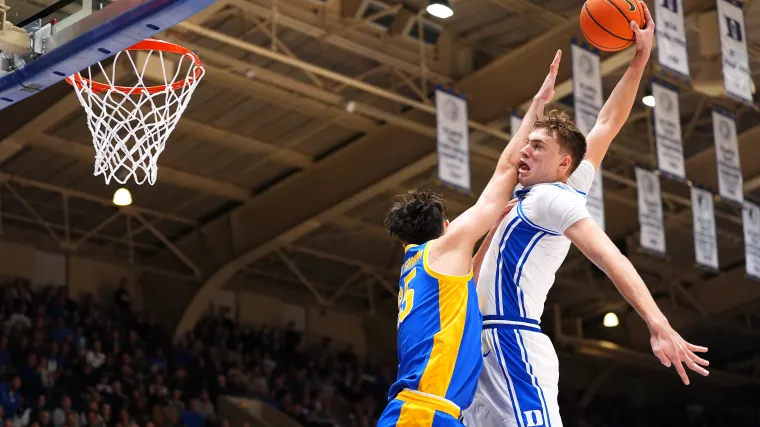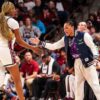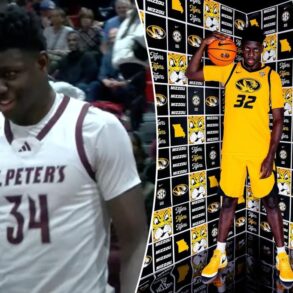Often we hear about how sports fans can begin to pay attention to college basketball once college football is entirely off the stage, which happens later than ever in the 12-team version of the College Football Playoff. Given that this great addition spreads only 11 games across the course of 43 days subsequent to Selection Sunday, I struggle to imagine what would prevent anyone from watching college hoops on the other 32 days.
It’s become standard, though, to open the door to the current basketball season right around now to those who’ve chosen not to become engaged to date.
What’s been happening?
Who’s good – both players and teams?
Any controversies to discuss?
We are here to help, across the board.
(Even though we know you’ve been watching all along. Except on football nights. Maybe.)
MORE: SN’s Midseason All-America team
The SEC is a basketball league now
Remember when Auburn vs. Alabama was about the Kick Six and Nick Saban and Jalen Milroe and Cam Newton? Yeah, now it’s the turf of Johni Broome and Mark Sears. Except the turf is made of wood, and the ball is round.
Here’s an absolutely wild statistic to show you how the landscape has shifted, at least for now, regarding the accomplishment of the top men’s athletic teams at the two schools: Even though the basketball teams at Auburn and Alabama will play more than three times as many games as their football classmates, the combined defeats are going to be in the same neighborhood at season’s end.
Auburn is 17-1 with 13 more games on the schedule, plus the SEC Tournament and NCAA March Madness. Alabama is 16-3 and has 12 more regular season games. The football teams finished a combined 14-11. There’s a chance the hoops teams will also finish with 11 combined losses.
That’s true even in an SEC so loaded it set a record for non-conference winning percentage (.889) and currently has seven teams in the KenPom.com top 20, a total of 13 in the top 50 and all 16 members ranked inside the top 85.
The SEC scheduled brilliantly. South Carolina, expected to be in a transition year, played only one team outside the conference – in-state rival Clemson – that is currently higher than 45th according to KenPom. Vanderbilt took a similar approach. Alabama and Auburn, who obviously figured to be among the top contenders, played a combined nine games against teams that are inside the KenPom top 25.
But it’s not enough just to schedule smartly. You have to win the games, too. And the SEC did. They were 36-13 against major opponents in neutral court games.
The question now becomes whether they can break every significant record relative to NCAA Tournament bracket selections.
Number of bids: The record is 11, set by the Big East in 2011, when the league had 16 members. The advantage the Big East had was a five-team bottom that recorded few victories against the 11 tournament teams. The advantage this SEC owns is the unparalleled non-conference dominance that makes it difficult for league members to get stuck with a “bad loss” in conference play. Likely.
Percentage of members selected: This is also owned by the Big East, set in 1991, when seven of the nine members were chosen (77.8 percent). To break this one, the SEC would have to have 13 selected. The BracketMatrix.com average of 77 online brackets currently has the league with 12 projected bids. Texas is the first team out. Less likely.
Number of top-4 seeds: Since 2001, there have been nine occasions on which leagues placed at least five members among the top four seed lines.You’ll be stunned to discover this mark also is held by the Big East, at least in part, which had five teams on the top four lines in 2009, 2010 and 2011, but those are tied with the 2021 Big 12 and Big Ten, the 2012 Big Ten and the ACC in 2004, 2015 and 2019 . The Matrix currently has five SEC teams on the first two lines, with seven on the top four lines and Texas A&M just outside. Lock.

Cooper Flagg is everything we said he would be
When Flagg committed to become a Duke Blue Devil for the 2024-25 season, I wrote that he was the best American prospect to enter the college game in more than a decade.
It’s always nice to be right.
But, to be frank, it was hard not to be. Flagg’s talent was that obvious to those who work in the game. He has a full package of skills, excellent size and dynamism and a profound understanding of how to impact the game.
He’s actually been better than many expected, because his deep shooting was one area in which he was not considered exceptional, even for a 6-9 power forward. But since Duke returned to ACC play in January, he’s hitting 55.5 percent of his 3-pointers (and averaging 25 points in that stretch, as a result).
It may be difficult for him to catch Player of the Year frontrunner Johni Broome, especially if Auburn’s terrific big man returns quickly from the injury that’s cost him two games.
Flagg’s goals no doubt are broader than winning the Naismith Award or The Sporting News Player of the Year. If Duke is able to win the 2025 NCAA Championship, the Devils would become the third freshman-dominant team – three starters are from the recruiting class of 2024 – to accomplish this since 2012.
I do wonder if analysts would then stop saying freshman-based teams are doomed to fail.
MORE: Cooper Flagg flashes vast potential at Champions Classic
Transfers don’t have to dominate your team
So many of the top teams in the sport are loaded with players gathered from the portal, the most obvious being Kentucky, with the team’s nine top scorers all in their first season with the Wildcats.
Not that there’s anything wrong with that.
However, those who insist success can’t be gained without heavy reliance on this device ought to take note of Michigan State, currently riding an 11-game winning streak with only two regulars in its deep, 10-player rotation who weren’t recruited out of high school.
Or how about Purdue, which featured just one transfer on its 2024 Final Four squad, and now has … none? Like, none on the roster, at all? And still is 15-5 and standing No. 10 at KenPom.com?
“What keeps me going is I’m too stubborn to give in to these stupid new rules,” Izzo told TSN at Big Ten Media Days. “I still want to do it the right way, making some adjustments to the new way. But I still enjoy the kids. I still enjoy the practices. I think I enjoy the games.”
He’s enjoying the games a lot more with a 16-2 overall record, a perfect Big Ten Conference start and an exceptional perimeter attack featuring point guard Jeremy Fears, wing Jaden Akins and reserve guard Jase Richardson.
Jase is the son of Jason Richardson, who is one of only two Izzo players to be a top-5 NBA Draft pick. But Jason also came off the bench for the Spartans’ 2000 NCAA Championship team. Izzo has done things his way for a very long time.
Bigger isn’t necessarily worse
With the ACC and Big Ten now coast-to-coast conferences, the Big 12 stretching from Phoenix to Morgantown and the SEC reaching all the way from Gainesville to Austin, a lot of teams are spending more time on planes than before.
And we do, perhaps as a result, see a few lopsided final scores.
There have been, however, blowouts in games that have been on the schedule for years – some of which require very little travel at all. Illinois bused a couple hours over I-74 to Indiana and won by 25. Tennessee took a 14-0 record along on a short trip to longtime SEC opponent Florida and lost by 30. Expansion doesn’t explain any of that.
There have been challenges in scheduling to accommodate the broader conferences, which hopefully will be resolved as everyone gains more experience in this area.
But Wisconsin against UCLA in January? Kansas against Arizona? Texas against Texas A&M? There are good outcomes of these expansions, as well.
Longer rarely is better
Those of us who have not yet seen Academy Award contender “The Brutalist” might be intimidated by its 3.5-hour run time, but those of us who have seen “Lawrence of Arabia” know you can go even longer and make it all fascinating.
However, those who put these films together were artists who thought about every second, every frame. Those who are turning 2-hour hoops games into 2-hour, 40-minute marathons are only worried about “getting the call right”.
The replay reviews at the end of college basketball games have become preposterous. I saw one game recently in which the final 2 minutes took 19 minutes to complete. There was nothing controversial along the way, just a constant parade to the monitor to check the time or to see if there was any evidence a particular player might have touched a basketball that was pretty obviously last touched by his opponent.
This is all the NCAA men’s basketball rules committee needs to accomplish next spring: Fix the monitor review process. Put in a challenge system similar to the NFL’s. Limit the amount of time that can be spent on a review. And, above all, only allow the head referee to check the monitor and make the decision. Never, ever, have two officials look at it, then a third, followed by a three-person conference before announcing the decision.
There’s nothing wrong with a 3-hour basketball game.
But we ought to be in the sixth overtime if we’re going that long.
This post was originally published on this site be sure to check out more of their content.






